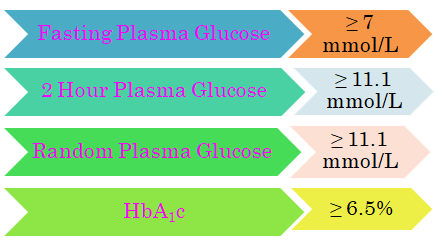Journal of
eISSN: 2374-6947


Mini Review Volume 7 Issue 2
Faculty of Medicine, AIMST University, Malaysia
Correspondence: Myat Thu Thu Win, Senior Lecturer, Faculty of Medicine, AIMST University, Malaysia, Tel 0197095162
Received: June 09, 2020 | Published: June 30, 2020
Citation: Win MTT. Novel effect of medicinal plants on diabetes mellitus. J Diab Metab Disorder Control. 2020;7(2):73-74. DOI: 10.15406/jdmdc.2020.07.00203
diabetes mellitus, hyperglycemic, α-glucosidase, β cells, insulin
DM, diabetes mellitus; HbA1c,haemoglobinA1c level; IGF, impaired glucose tolerance; IFG,impaired fasting glucose; AGEs, advanced glycation end products;DPP-IV, dipeptidyl peptidase-IV
Diabetes mellitus (DM) is a chronic non-communicable disease and 422 million people had DM in 2014.1 There is increasing in number of DM and about 642 million people will be expected to suffer from DM in 2040.2 It can be diagnosed by high blood glucose level (hyperglycemia), increased haemoglobinA1c level (HbA1c), fatigue, weight loss, polydipsia, polyuria Figure 1. There are Type 1 diabetes (insulin-dependent, juvenile or childhood-onset), type 2 diabetes (non-insulin-dependent, or adult-onset), gestational diabetes which occurs during pregnancy, impaired glucose tolerance (IGT) and impaired fasting glucose (IFG) which are intermediate conditions between normal and diabetes and unclassified diabetes3. So, novel effects of medicinal plants are needed to discover for new therapeutic agents for DM Figure 2.

Figure 1 Modified diagnostic criteria for DM.3
Sources and effects of medicinal plants
Australian medicinal plants such as Petalostigmapubescens, Petalostigma banksia which have α-amylase inhibition, α-glucosidase inhibition and glucose-induced fluorescent advanced glycation end products (AGEs) inhibition but further study is needed for using as treatment of DM.4 Sudanese medicinal plants like Acacia nilotica, Ziziphus spina-christi, Geigeriaalata showed that they have potent antioxidant, anti-hyperlipidemic and α-glucosidase inhibition properties so it will be expected to use as plant derived antidiabetic agents after animal and clinical studies.5 A very valuable medicinal plant Kothalahimbutu also known as Salacia reticulata seen in Sri Lanka and South India have multiple effects like antioxidant, hepatoprotectant effects and inducing effects on aldose reductase, peroxisomal proliferator-activated receptor-α, glucose transporter-4 mediated glucose uptake. In addition to this, Salacia oblonga extracts significantly lower the postprandial glucose curve in type 2 diabetic patients.6 Likewise, Berries extract and its compounds have beneficial effects on DM and metabolic diseases by improving insulin resistance and reduce inflammation to regulate the blood glucose effectively. The hyperglycemic control effect is similar to metformin drug used in type-2 DM patients.7
Medicinal plants like Momordicacharantia which fruits (bitter gourd) have critical role in stimulating isolated pancreatic β cells to secrete insulin in obese hyperglycemic mice and to renew β cells and to recover damaged β cells in Streptozocin induced diabetic rats. It was suggested that the novel effect of this extract may reduce not only hepatic glycogenesis but also increase glucose utilization in periphery.8 It can inhibit α-amylase and α-glucosidase in vitro and reduce blood glucose level in Streptozotocin-induced diabetic rats when they were given orally. These two enzymes may play a role in carbohydrates metabolism and cause postprandial increase glucose level in diabetic patients.9 One of the medicinal plants which have beneficial effect on DM is resveratrol. It has many different mechanisms like prevention of abnormal glucose uptake and storage, apoptosis and dysfunction pancreatic β cells and improved insulin resistance.10 Similarly, traditional plants used in Persian medicine (e.g. Bambusaarundinasi, Coriandrumsativum, Myrtuscommunis) have antidiabetic effects by increasing insulin, liver glycogen, inhibiting deteriorative changes in β cells and α-glucosidase enzyme inhibition. So, these plants may be useful for prevention and treatment of diabetes and complications.11 In addition to this, researchers are trying to explore the anti-hyperglycemic effects of different medicinal plants is increasing because of lower costs and lesser side effects of medicinal plants. Recent study showed that plant origin quercetin and coumarin have inhibitory effects on dipeptidyl peptidase-IV (DPP-IV) enzyme which increases endogenous incretins activity results in insulin stimulating effect and reduce blood sugar level. Both of them have not only anti-hyperglycemic action but also antioxidant action.12
In spite of many medicinal plants have antidiabetic properties by acting different mode of mechanisms, the development of novel therapeutic agents for DM is still awaiting. Further studies are required for safety issues and clinical trials are essential for use as treatment and prevention for DM in human.
None.
The author declares that there is no conflict of interest.
None.

©2020 Win. This is an open access article distributed under the terms of the, which permits unrestricted use, distribution, and build upon your work non-commercially.